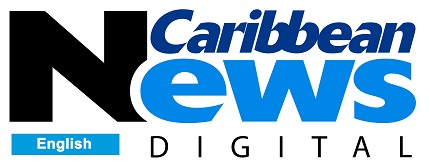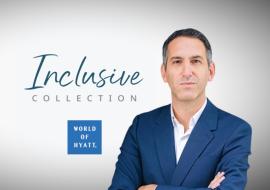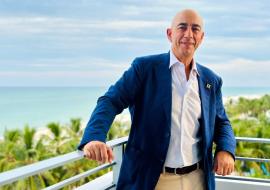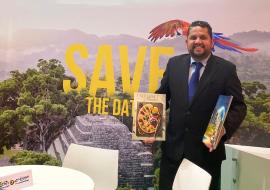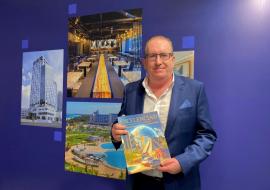Barry Roberts. Costa Rican Tour Operator
<b>Q- Mr. Roberts, what’s your current job within the realm of tour operations? </b>
A- Operatively speaking, what I’m trying to do right now is to indulge myself into mapping out new strategies for a number of development paths at a regional level, either national or entrepreneurial paths, so to speak.
<b>Q- From your position, how do you assess Costa Rica’s latest development in the travel industry? </b>
A- Fortunately, we’re spinning out of what panned out to be the country’s best high-peak season ever. I think this is owed to a couple of basic reasons. First of all, the detour taken by a part of American travelers that used to favor such destinations as the Middle East and Asia in the past. The same has happened with European trekkers. Given a fear to travel triggered by violence and diseases, these tourists are now choosing Central America and, in a way, Costa Rica, a country that’s widely known as a safe destination in many ways, including sanitation and security. But perhaps the most important factor of all is the increase in the number of flights that Costa Rica has brought to itself over the past year. There’s been a 43 percent hike in the number of available plane seats, and this has generated more development for Costa Rica, somewhere in the neighborhood of 15 percent since last year.
<b>Q- As far as the Central American region as a whole, what do you think of its development in terms of tourism? </b>
A- I believe there are three key elements worth taking into account in this sense. First of all, the region’s undeniable natural attractions –variety and diversification of its products in terms of indigenous, ecological and even humane culture- are very visible. That’s a key factor. On the other hand, the region has taken stronger steps toward peace and stability; there are no violence problems, guerrillas, or something like that. The third factor is the Central American unity, especially when it comes to dealing with Europe, the world’s largest tourist-sending market. The foundation of CATA, headquartered in Madrid and run by Gabriel Vega Camargo –a highly capable Mexican national- shows a stronger unity that’s destined to pay off as it is paying off right now. We’re now hearing the first announcements of nonstop flights from Europe to Central America. There’s also more interest on the part of tour operators in domestic multi-destinations within the Central American region. In a word, I can tell you that Central America’s travel prospects can’t be any brighter.
<b>Q- As to the investment process now underway in the region, is there anything you’d like to tell us? </b>
A- That’s precisely one of the biggest concerns for all countries. For instance, last week I attended the Second Meeting of Guatemala’s National Impresarios that gathered over 900 businesspeople and the Guatemalan President, including several member of his cabinet. The Salvadoran President was there, too, and he was very interested in the issue of working out the kinks on new ways to bring more investment to the region. This kind of meeting speaks volumes of the tremendous interest that the new Guatemalan administration has in this issue. On the other hand, I’ll soon head for Nicaragua to take part in a similar event there.
The new Salvadoran President has already disclosed his plans in this direction, and some of them have to do with efforts to bring more investment. From all of the above, we must say there’s a need to implement an effective strategy in order to raise interest in tourism and bring more investment capital.
Yesterday I talked to Gabriel Escarrer, president and owner of Sol Meliá, and, I mean, that was one of the most important issues in our conversation. He told me, “I’ve got so many options in front of me that unless somebody gives me reasons good enough to make a different decision, I’ll be definitely turning to those places that can provide me with easier and quicker ways to develop my business.” That makes sense. You bet that makes sense. We need to make more emphasis on this matter because the potentials are huge and the future can’t be any brighter for investors coming to our neck of the woods. You bet the region is going to take off from a tourist viewpoint.
<b>Q- How do you see the development of multi-destination between Central American countries and Caribbean states, for example, between Cuba and Costa Rica? </b>
A- I believe our leaders should pay more heed to the fact that we’re living in a globalized world, and unless we hear the wakeup call and start acting more cunningly, I mean, unless we stop seeing each other as competitors and begin to support one another in a mutual way, unless we start working on the basis of beefing up our own strengths and piecing together a multi-destination strategy we could both benefit from, we’ll wind up doing a lot of harm to one another.
Tourism is an industry fully controlled by demand, so if a customer wants to travel to Cuba and Costa Rica, we must give him that possibility. That’s a part of the reality that we live. I think multi-destination is by far one of the most important areas in tourism development, especially for those nations that are far from Europe.
<b>Q- What about the TACA PASS? Do you think it could play a role in either strengthening or increasing this modality? </b>
A- Absolutely. I think the TACA PASS is a good decision. This is an initiative developed by the TACA Group in order to get a much bigger international turnout. The point is that a considerable chunk of Central America’s problems stems from the lack of roads that could bring us together in a more effective way and make tourists reach out to our different destinations in each and every country. Air transportation is an extremely useful tool and, in this respect, the TACA PASS is a good step in the right direction.
<b>Q- How is the country working out its environmental protection problems? </b>
A- Since 1972, Costa Rica founded a National Park System that has raised ecological awareness and has definitely put us on the map as an environment-friendly destination. I must say the Costa Rican people have kind of matured in this sense in a real, rather than commercial, way. We’re confident that in order to advance in terms of sustainable development, we ought to meet our needs without sacrificing the necessities of our children and grandchildren. Environmental protection has become a top priority, yet we haven’t given it all the attention it actually needs. Despite the fact that we have national parks that were built over three decades ago –we haven’t yet refunded those whose lands were seized to build those parks- we still have a long way to go. However, the good thing is that we’re on the right track. That’s the most important thing for Costa Rica.
<b>Q- Is there anything else you’d like to add? </b>
A- I’ve always wondered why there isn’t far more integration among mass media, the political sector and the entrepreneurial sector. I know your group is the exception to the rule because I’m aware of how hard you work for the sake of this integration. There’s something that’s crystal-clear to me; tourism is an industry controlled by demand, an industry that moves around in different means. Yet, news organizations are the ones exerting the biggest influence of all. Ninety-nine percent of the people design their own tourist products and then they try to find out how they’re going to market that product. I strongly feel that any product must insert details about the way that product is going to hit the markets. Even communication should be a part of that new product because, at the end of the day, that’s the tool to sell the product. We need to work closer together in that particular field, you know, do some teamwork. I know there are times when some hostility pops up between the media or certain journalists and tourism experts. The point is that some news organizations make a living out of stirring up a hornet’s nest in order to make their primetime news slots climb in the rating war. But there are media organizations, like yours, that follow the right direction. Journalists should make up teams rather than sling mud at one another, and work together for the sake of the development of a product that should be intended to increasingly meet the demands and expectations of those who make it. I congratulate you from the bottom of my heart and I urge you to keep up the good work and stay on the right track.






